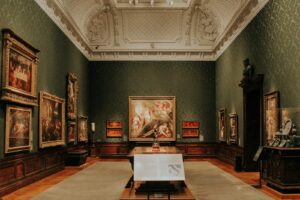Diving into the world of art collecting can feel like stepping into a vast, uncharted territory. With so many styles, artists, and mediums, knowing where to start can be overwhelming. That’s where our art collecting tips come in handy. Whether you’re drawn to the dark, surreal paintings or the serene beauty of pastel flower gardens, understanding the basics is your first step to curating a collection that reflects your unique taste.
But art collecting isn’t just about picking what you like; it’s about recognizing quality, understanding market values, and knowing where to find those hidden gems. Our guide will equip you with the essential art collecting tips to begin your journey confidently. From setting clear goals to making your first purchase, we’ve got you covered. Let’s embark on this exciting adventure together, and transform your passion for art into a collection that tells a story uniquely yours.
Setting Clear Goals
When embarking on your art collecting journey, setting clear, actionable goals is fundamental. Whether you’re drawn to original paintings by well-known artists or the pure, raw talent of new artists from major art schools like the Royal College or Central Saint Martins, defining your objectives upfront will steer your path. Aiming to build a strong art collection? Here are three critical areas to focus on:
- Identify Your Passion: Do you have a penchant for oil paintings, fine art photography, or limited edition print projects? Knowing what type of art and artists you’re passionate about—not just as a pure investment but as a joy—will guide your art acquisition efforts. It’s about more than just buying art; it’s about curating pieces that resonate with your personal taste and enhance your living spaces or create beautiful interiors.
- Educate Yourself: Diving into the art world requires a mix of research and immersion. Attend art fairs, gallery openings, and auction houses to see a wide variety of artworks. Make it a point to visit galleries showcasing emerging artists and exciting emerging artist groups. Knowledge of the art market, understanding the significance of artist’s career milestones, and awareness of trends help in making informed decisions. Becoming a knowledgeable art collector isn’t just about who you know; it’s also about what you know.
- Network and Build Relationships: The path to becoming a seasoned art collector involves building relationships within the art community. This can mean developing a rapport with gallery owners, becoming a personal client to a particular artist, or joining interesting and thriving communities. These connections can provide essential tips, insights into new artist showcases, and access to group exhibitions. Networking can also lead to opportunities for acquiring art directly from artists or securing invitations to private sales, where you can add stunning original paintings or original art to your own art collection.
Exploring Different Art Styles
Embarking on your art collecting journey is thrilling, full of discoveries and personal growth. As you dive into this vibrant world, one of your first steps should be exploring various art styles. This exploration is key to understanding what resonates with you personally and will shape your future collection. Whether you’re drawn to the timeless elegance of oil paintings or the modern appeal of photographic prints, seeing a wide range of artwork is essential.
To start, consider attending art fairs and local art galleries. These venues are fantastic for seeing a variety of art in person and can help you develop an insight into different artistic methods and materials, from stunning original paintings to limited edition print projects. While there, engage with gallery owners and artists. Their insights can offer valuable collecting advice and introduce you to the next generation of emerging artists. Pay attention to group exhibitions, which often feature works by particularly exciting emerging artists from major art schools like the Royal College or Central Saint Martins.
Moreover, take advantage of digital platforms to further explore the art world. Online galleries and social media allow you to follow artists and discover new talents from interesting and thriving communities across the globe. This digital exploration can be especially helpful for identifying emerging artists whose artist’s career might be on the cusp of breaking into the mainstream. Keep in mind, as you start collecting art, to look for pieces that not only appeal to you aesthetically but also connect with you on a deeper level. This emotional connection can significantly enhance the value of your own art collection, transcending the purely investment aspect of art acquisition.
Understanding Market Values
When embarking on your art collecting journey, understanding the market values of art is crucial. Knowing what drives the value of art pieces, from original paintings by well-known artists to limited edition print projects by emerging artists, will guide your purchasing decisions. Collecting art isn’t just about finding pieces you love; it’s also about knowing their worth in the art market. Whether you’re at art fairs, local art galleries, or exploring major art schools like the Royal College of Art or Central Saint Martins for the next generation of exciting emerging artists, grasp these insights to hone your art acquisition skills.
- Visit a variety of art fairs and gallery openings to discover new artists and learn about different styles.
- Follow artists from their early career stages, especially those who have graduated from major art schools, to potentially invest in their work before they become well-known.
- Understand that the history of a particular piece of art, including its previous ownership and how it fits into the artist’s career trajectory, can significantly impact its market value.
- Consider the rarity of a piece; original prints and limited edition artworks tend to hold or increase in value over time.
- Engage with gallery owners and auction houses for professional collecting advice and market insights.
- Focus on artworks based on acid-free paper or other durable materials to ensure longevity and preservation of value.
- Establish relationships with emerging artists by visiting group exhibitions and degree shows at art schools.
- Realize that the art market is dynamic; the value of artworks can fluctinate based on trends, artist recognition, and art world events.
- Diversify your art collection across different mediums and styles to hedge against market volatility.
- Always seek a comprehensive guide or personal client advisory when considering significant acquisitions to navigate the complex art market efficiently.
Finding Hidden Gems
Starting or expanding your art collection can be a deeply rewarding journey, infused with personal discovery and the thrill of the hunt. Here, we delve into strategies for uncovering those elusive, unique pieces that can transform your collection from good to extraordinary. Remember, discovering emerging artists and hidden artworks is about more than just adding pieces; it’s about supporting the art world and becoming part of vibrant, thriving communities.
- Attend Art Fairs and Galleries: Art fairs and local art galleries are fertile grounds for discovering new talent. Emerging artists often display their work here first, offering a fresh perspective and original art. Keep an eye out for gallery openings and group exhibitions; they’re great places to discover an exciting emerging artist and start collecting art that resonates with your taste.
- Explore Art Schools and Auction Houses: Major art schools such as the Royal College and Central Saint Martins showcase the next generation of artists through degree shows. These events can be goldmines for finding stunning original paintings and artworks based on particular styles or themes. Similarly, don’t overlook smaller, less mainstream auctions. They can be excellent venues for acquiring original prints and limited edition print projects at reasonable prices.
- Build Relationships: Perhaps the most insightful tip for aspiring collectors is to build relationships within the art community. This includes artists, gallery owners, and fellow collectors. These connections can offer exclusive insights, collecting advice, and access to private sales or artist’s career highlights before they become widely known. Becoming a personal client of a gallery or a particular artist can also open doors to collect art that never makes it to the public eye.
Making Your First Purchase
When you’re ready to make your first purchase in the art world, it’s essential to approach it with confidence and a well-informed mind. Whether it’s about finding that stunning original painting by an exciting emerging artist or adding a limited edition print to your collection, each acquisition is a step forward in your art collecting journey.
- Research Thoroughly: Before diving into your first purchase, get to know the art market and discover emerging artists whose work resonates with you. Visit art fairs, local art galleries, and major art schools like the Royal College of Art or Central Saint Martins to explore the works of next-generation talent. Read up on collecting advice from seasoned art collectors to understand the nuances of acquiring art.
- Understand the Value: Learn what makes a piece of art valuable. Is it the rarity, the artist’s career trajectory, or the medium? Knowing why limited edition print projects or original paintings are prized will help you make educated decisions. Remember, an artwork’s worth isn’t just in its price tag but its potential to enrich your art collection and personal space.
- Build Relationships: The art world thrives on connections. Start building relationships with gallery owners, art collectors, and artists. These connections can offer you insider knowledge, invite you to exclusive gallery openings, and alert you to emerging artists with promising futures. Such relationships often lead to acquiring good art from thriving communities and may even offer opportunities to purchase original art directly from the artist.
- Consider Your Space: Visualize where the artwork will hang in your home. Will it create beautiful interiors or clash with your existing decor? Sometimes, a photographic print might suit your modern apartment better than an oil painting. And remember to ensure the art is framed on acid-free paper to preserve its quality over time.
Wrapping up: Art Collecting Tips
Embarking on your art collecting journey is an exciting endeavor that blends passion with astute decision-making. Remember, the art you choose to bring into your life should not only be an investment but also a reflection of your personality and aesthetic preferences. By leveraging the insights and strategies shared, you’re well-equipped to navigate the art world with confidence. Don’t rush the process—take your time to explore, learn, and connect with the community. Each piece you select is a milestone in your collecting journey, adding depth and value to your personal collection. Let your love for art guide you, and you’ll find that each acquisition enriches your space and your life in unique ways. Happy collecting!



